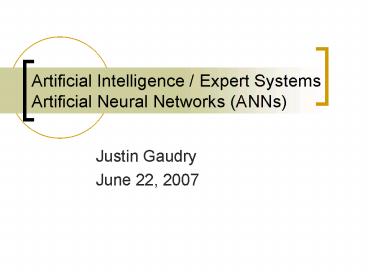Artificial Intelligence Expert Systems Artificial Neural Networks ANNs - PowerPoint PPT Presentation
1 / 18
Title:
Artificial Intelligence Expert Systems Artificial Neural Networks ANNs
Description:
depth searches not feasible due to high branching at each level ... Connectionist learning models store patterns of activity in networks of small, ... – PowerPoint PPT presentation
Number of Views:516
Avg rating:3.0/5.0
Title: Artificial Intelligence Expert Systems Artificial Neural Networks ANNs
1
Artificial Intelligence / Expert
SystemsArtificial Neural Networks (ANNs)
- Justin Gaudry
- June 22, 2007
2
Neural Networks
- Layered network of artificial neurons
- Applicable to large state spaces
- table lookup is impossible
- depth searches not feasible due to high branching
at each level - Alternative to database lookup combined with
heuristic search - Allows for pattern recognition and the appearance
of judgment
3
Neurons
- Connectionist learning models store patterns of
activity in networks of small, individual
processing units - Modeled after animal brain activity
- Artificial neurons are models of biological
neurons
4
Biological Neurons
- Receives input from dendrites
- Fired through the soma via action potential
- Output through the axon to other dendrites
- Dynamically changes number and strength to other
neurons (plasticity) - Strengthens connections providing correct answers
and weakens those providing incorrect answers - Weakened connection causes less likelihood that
action will be taken
5
Artificial Neurons
- Nodes
- As a model, need dendrites, soma, action
potential, and axon - As a model, need input, activation function to
provide activation level, and output - Input to node causes activation to all connected
output - In a network, each node receives a signal from
input or other nodes and fires to all connected
nodes
6
Domain
- Formulation as a state-space search
- Ability for occasional reinforcement
- Large cardinality of states
- Inexactness (allowing partial match)
- Approximation (to get close enough)
7
Advantages
- Continuous, multivariable function
- H(w,x)
- w is weight vector, x is input vector
- Avoids blemish effect
- Lack of a smooth transition from one stage to the
next - If several stages possible at once, rules
contradict
8
Non-Linearly Separable Problems
- Linearly separable problems can divide potential
outputs with a line - Can be represented with a linear function
- AND, OR, and NOT are linearly separable
- Non-linearly separable problems cannot cleanly
separate outputs with a line - XOR is non-linearly separable
9
Activation Function
- A continuous nonlinear sigmoidal activation
function enables a neural network to map smooth
nonlinear functions of its input - Allows for robust approximation capabilities
10
XOR
11
Usually More Complex
12
Types of Neural Networks
- 2-layer (associative, Hopfield, Hebb)
- Multi-layer feedforward (backpropagation)
- Temporal (recurrent and time-delay)
- Self-organizing (Kohonen)
- Supervised and unsupervised
13
2-Layer Associative Network
- Feedforward
- Supervised learning
- Multiplies an input data vector against a
two-dimensional matrix of weights resulting in an
output data vector - 1x20 20x50 -gt 1x50 for example
- Linear architecture
- Cannot approximate nonlinear functions
14
2-Layer Network Procedure
- X Swixi
- as I goes from 1 to N where N is the number of
input nodes - Y 1 for X gt t and 0 for x lt t
- where t is a threshold
- Often written as Step(X) therefore
- Y Step(Swixi)
15
Multi-Layer Perceptron
- Incorporates a layer of hidden nodes
- Feedforward
- Usually supervised learning
- Input recoded into an internal representation via
multiplication through a weight matrix - Output generated by the internal representation
rather than original input via multiplication
through a secondary weight matrix - Multiple hidden layers can be incorporated
16
Multi-Layer Perceptron
17
Temporal
- Has connections that go from output back to input
serving as memory - Can also have arbitrary connections between any
nodes - Applicable when output depends on all previous
inputs
18
Self-Organizing Network
- Unsupervised learning
- Kohonen
- Topographic map formation
- Spatial location of an output neuron corresponds
to a particular feature of the input pattern - Hebbs Law
- If two neurons on either side of a connection are
activated synchronously, increase weight - If two neurons on either side of a connection are
activated asynchronously, decrease weight































